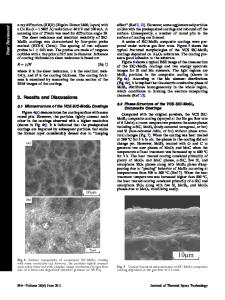Plasticity Enhancement of MoSi 2 at Elevated Temperatures Through the Addition of TiC
- PDF / 3,506,002 Bytes
- 6 Pages / 420.48 x 639 pts Page_size
- 102 Downloads / 276 Views
PLASTICITY ENHANCEMENT OF MoSi 2 AT ELEVATED TEMPERATURES THROUGH THE ADDITION OF TiC H. CHANG, H. KUNG AND R. GIBALA Department of Materials Science and Engineering University of Michigan, Ann Arbor, MI 48109 ABSTRACT Monolithic MoSi2 and MoSi 2 -TiC particulate composites with 10 vol % and 15 vol % TiC were tested in compression between 950'C and 12001C. The MoSi 2 TiC composites can be deformed plastically at lower temperatures than MoSi2 can before brittle fracture occurs. The composites exhibit much lower strain hardening rates and attain zero strain hardening rate at much lower strains than monolithic MoSi 2 . The differences between the composites and monolithic MoSi 2 in plasticity and in strain hardening behavior is attributed to efficient dislocation generation into the matrix from sources at the MoSi 2 -TiC interfaces. INTRODUCTION MoSi 2 exhibits limited plasticity at temperatures from 9001C to 13000C such that various authors have ascribed the brittle to ductile transition temperature (BDTT) to be in this temperature range [1]. Between about 900"C and 13001C, MoSi 2 exhibits limited deformation capability. Above about 1300'C, substantial plastic flow in compression has been observed [2]. In this paper, we investigate how the plasticity of MoSi 2 can be enhanced in this transition region of limited plasticity by the addition of a more deformable phase. TiC is a candidate phase for enhancing the plasticity of MoSi 2 in this temperature range. It deforms to large strains in compression around 900°C and above [3,4]. This plasticity is attributed to the change from slip on NaCl slip systems to slip on fcc slip systems at its BDTT of 600'C to 800°C. Previous experimental work [5,6] and thermodynamic calculations [5] have shown that TiC and MoSi 2 are chemically stable. No high temperature interfacial reaction products have been observed between these two compounds. TiC has a lower density than MoSi 2 (4.9 g cm" 3 vs 6.3 g cm- 3 ) and a higher melting point (about 3140'C vs 20301C). The coefficient of thermal expansion of TiC at 1000'C is 7.7 x 10-60C-1 and of MoSi2 at 10000C is 8.5 x 10-6°C-1 [7]. In addition, TiC exists in a wide range of substoichiometries from the maximum stoichiometry TiC 0 .9 7 . Substoichiometric TiCx decreases in strength with decreasing carbon content x [4]. This variability in strength may be a useful parameter in optimizing any plasticity enhancement effect of the carbide. EXPERIMENTAL PROCEDURE Monolithic MoSi 2 and MoSi 2 -TiC composites with 10 vol % TiC and 15 vol % TiC have been compression tested between 950'C and 1200'C. These three materials were prepared by hot pressing commercially available powders at 1700'C for one hour at 29.4 MPa. The MoSi 2 is 5 to 6 micron size powder from CERAC, Inc.; the TiC is 2.5 to 4 micron size powder from Johnson Matthey, Inc. Mat. Res. Soc. Symp. Proc. Vol. 273. @1992 Materials Research Society
254
with a nominal stoichiometry of TiC 0 .95 . The monolithic MoSi 2 and 10 vol % TiC composite were in addition hot isostatically pressed (HIPed
Data Loading...











